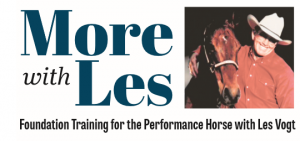 When you first start the exercise, I think it’s a good idea to push him up with both legs and then open your inside leg as you start the turn to help the horse find the move that you’re after. Also, approaching the turn with some inside leg will discourage your horse from leaning on your inside rein as you start to turn. If you feel him starting to lean, you might want to go back to exercise number two for a while and lighten him up. One thing to be careful of is that if he starts to lean or twist his head in the turnaround, he could end up shifting his weight to the outside hind leg, rather than the inside. We’ll be riding him into the turn with both legs once he gets the hang of it, but opening your inside leg at first is fine and can help your horse along.
When you first start the exercise, I think it’s a good idea to push him up with both legs and then open your inside leg as you start the turn to help the horse find the move that you’re after. Also, approaching the turn with some inside leg will discourage your horse from leaning on your inside rein as you start to turn. If you feel him starting to lean, you might want to go back to exercise number two for a while and lighten him up. One thing to be careful of is that if he starts to lean or twist his head in the turnaround, he could end up shifting his weight to the outside hind leg, rather than the inside. We’ll be riding him into the turn with both legs once he gets the hang of it, but opening your inside leg at first is fine and can help your horse along.
As you draw with your outside rein, remember that your goal is to only restrict the movement of the inside hind leg. The front legs and the outside hind leg should maintain the very same cadence in the turn that you had in your circle. Don’t expect that right away, but it’s your goal. What you want is for your horse to find a hole to fall into, a sweet spot where things are easy. And you make things easy by making sure you have the right angle and by finding just the right amount of pressure to use on that outside rein. You learn this by starting with some slack and then lightly “feathering” back with your outside hand until you feel him start to just slow down the inside hind leg. Then keep your hand right there—that’s the spot—if anything, start driving a little here with your outside leg (making sure your inside one is off of him) and let him find his way around.
You will learn with experience how much pressure it takes to initiate the turn – it becomes very natural. But before it can become natural, you have to experience the feeling you just got by creating the right impulsion and bend and then drawing back ever so slightly to start the turn. If the horse stalls and starts to back up, that’s where you need to push. In fact, you always want to feel sure that if you released the pressure from that outside rein your horse would just fl ow forward again, without having to shift his weight.
There’s no doubt you’ll have to experiment to get it right, and it’ll take some time. But you’ll finally recognize when it’s right because there’s almost no effort to it. It just feels easy and comfortable.
Remember, no neck rein
I also want to emphasize that we didn’t ask the horse to turn with a neck rein. You want to keep that outside rein away from his neck at all times while you’re doing this. One reason for this is that I often see riders who want to push so hard with that outside rein that they start pulling the horse’s head the wrong way. But the main reason is that your horse doesn’t know how to neck rein yet! In this program, we want to teach him all the maneuvers first and then teach him to respond to the neck rein. We don’t introduce the neck rein until the form is perfect so we never find ourselves dragging the horse around. In the traditional reined cowhorse approach we don’t start teaching a horse to neck rein in earnest, until he’s five or six and we’re riding him in a two rein (bosal and bridle) set-up.
Learning a New Dance Step
As you start to work on your turnarounds, approach them nice and slow. Don’t make it a big deal. I’m really tickled if I just get him crossing over a step or two at fi rst if he keeps his neck soft and relaxed. Don’t force anything. Just set him up correctly, drive him up and let him step across, almost by mistake! Then reward him like crazy. The turnaround is not a natural move for the horse – and while you only have two legs to worry about he has four! Let him take his time and build his confi dence. And don’t worry about locking that pivot foot into the ground at this point – in fact don’t even think about it. Concentrate on gett ing the front legs stepping across in a free, relaxed manner. If you get the front of the horse right, the back end will follow!
–Les
Leave a Comment
All fields must be filled in to leave a message.